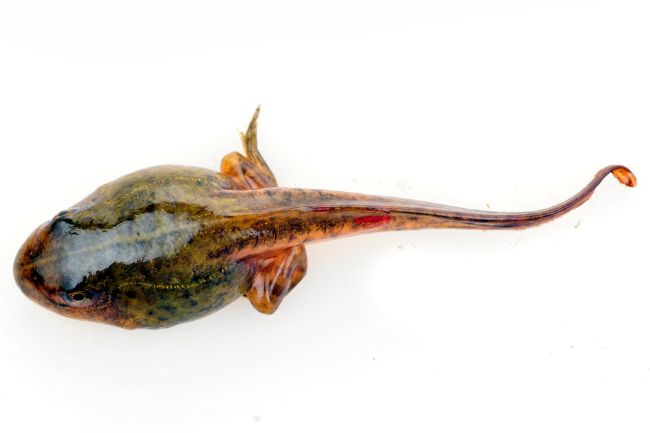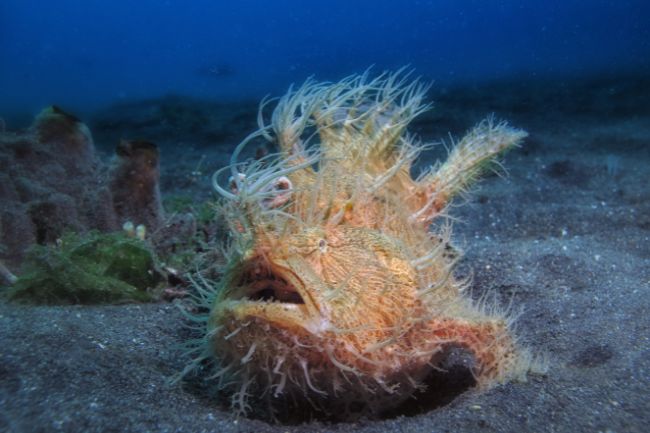The way frogs breathe changes throughout their life, as they breathe through gills as tadpoles, and then largely lungs as adults.
Can Frogs Breathe Underwater?
Most species of frog start their life in a fully aquatic form, known as a tadpole. Tadpoles look similar to fish, having a small oval body, and a long tail, that helps propel them through the water.
Tadpoles start life as eggs, that are usually laid in large clusters within water bodies. Adult frogs tend to look for relatively still pools, with few predators, to lay their eggs in. This could be a pond, ditch or lake. Some eggs are laid in temporary pools, such as puddles or pools within hollow stumps.

Hatching from their eggs into the water, tadpoles will live an aquatic life until they begin to change into froglets. In their aquatic home, pre-transformation, tadpoles breathe through gills.
Gills allow many aquatic animals to live underwater, without needing to visit the surface to breathe. This has many advantages, not least of which is safety, as many surface-dwelling animals feed on creatures coming up to take a breath.
Gills work by moving water over a thin membrane, where there are many tiny blood vessels. There gas can be exchanged between the water and the animal’s body. Carbon dioxide, a waste product, is released, while oxygen is absorbed.
As well as many amphibian species, gills are commonly found in fish species. The strange thing with frogs and toads, is that gills are only present in tadpoles. As the tadpoles slowly change into juveniles, they grow legs, and absorb their gills into their skin.
Although tadpoles rely heavily on their gills, they do also breathe in other ways. Firstly, they can breathe through their skin. This is because their skin is very thin, and they have blood vessels close to the surface. As with their gills gas exchange is able to occur.
Finally, the tadpoles are able to use their lungs as well. Although their lungs more fully develop as they become froglets, they do have small lungs when they hatch.
In order to avoid pools where predator numbers may be high, frogs often choose water bodies with relatively low oxygen levels. Because of this they often can’t get enough oxygen from the water.

The tadpoles therefore occasionally pop up to the surface to gulp in the air from above the pool. Due to their size however, they are sometimes too small to break the surface tension of the water. Smaller tadpoles have been found to suck at the surface of the water, pulling in an air bubble and closing their mouth around it.
Also read: Frog Reproduction and Their Life Cycle
How do Frogs Breathe on Land?
While there are some species of aquatic frog, who spend all their time in water, even when they’ve become adults, all adult frogs breathe almost entirely through their mouth, nose and lungs.
The gills that helped them breathe when they were younger have disappeared, and their lungs have fully developed. However, compared to the lungs of many other land animals, frog lungs are relatively underdeveloped. For one thing they don’t have a diaphragm.
The diaphragm is a key mechanism for helping the lungs to pump air in and out. By contracting and relaxing it makes the lungs bigger and smaller. The compressed lungs force air out, whereas expanding lungs pull air in.
Instead, frogs use their mouth to act as a pressure chamber. They pull air into their mouth by moving their throat muscles, but keeping the opening to their lungs closed. They then close their nose and mouth and open their lungs, forcing air down into them.
However, breathing through their lungs alone isn’t enough to give frogs all the oxygen they need. They therefore also breathe through their skin and buccal cavity.
Another name for the buccal cavity is the mouth, and frogs are able to breathe just by taking air into their mouth, rather than taking it down into their lungs.
And finally adult frogs, like tadpoles, can breathe through their skin.
Also read: Frog Hydration: How Do They Drink Water?
How do Frogs Breathe Through Their Skin?

Cutaneous breathing is an important breathing method for frogs. When they are hibernating, or underwater, this is the only way adult frogs can bring oxygen into their bodies.
Frogs breathe through their skin in a passive way. Rather than actively pulling the air into their bodies, it moves through the thin membrane due to the natural pressures between the blood and the surrounding water or air.
Blood vessels close to the skin’s surface let waste gasses like carbon dioxide escape while absorbing oxygen and carrying it around the frog’s body. It’s for this reason that frogs can spend so long underwater without needing to surface.
Also read: Do Frogs Have Hair? What is Frog ‘Hair’ Exactly
How Long Can Frogs Breathe Underwater?
In theory frogs can breathe underwater for as long as they like, however, how long they can actually stay underwater without requiring additional oxygen is likely to depend on a number of factors.
Temperature
Temperature is an important factor in oxygen consumption. In warmer periods, or climates, the frog’s metabolism will be working harder. This means that they will need to absorb more oxygen, more quickly.
During colder periods, such as winter, many frog species will also hibernate. Hibernation is a state where animals lower their metabolism and heart rate in order to enter a sleep-like state. During this time their oxygen demand will therefore be particularly low.
Oxygen Levels
Frogs often choose to inhabit waterbodies with lower oxygen levels. This is because these will be naturally lower in some of their main predators, like fish. However, this may also mean that they cannot get enough oxygen from the water to stay underwater for long periods of time.
Frogs often use temporary wetlands, such as pools that dry up over time. As these pools heat up and disappear they naturally lose a great deal of oxygen.
Species
Different species of frogs are adapted to different lifestyles. Some species are aquatic, and may have particularly thin skin, to make breathing underwater easier. Others spend most of their time on land, and may not spend very long underwater.

One frog that has particularly interesting adaptations to staying underwater is the hairy frog. This frog has hair like protrusions that act as extra skin surface area, helping it to absorb more oxygen. This adaption is believed to have occurred to allow the male frogs to stay underwater for longer, in order to guard their eggs.
Deep Breathes
The many ways frogs breathe certainly makes it a fascinating animal to study. From breathing through their skin, to losing their gills as they age, frogs certainly have a large number of options for how to get their essential intact of life giving oxygen.

